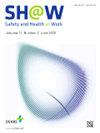长期使用不同口罩对其物理性能的影响及对佩戴者的生理影响
IF 2.9
3区 医学
Q1 PUBLIC, ENVIRONMENTAL & OCCUPATIONAL HEALTH
引用次数: 0
摘要
大多数已发表的关于潜在的口罩物理性能和生理损伤的研究都有较短的观察时间,并且观察到的职业物理活动与实际职业工作的相关性有限。因此,我们的研究旨在评估长时间使用口罩对其物理性能和佩戴者相关生理反应的影响。方法研究参与者的招募于2022年11月至2023年3月进行。使用TSI 8130型自动过滤器测试仪和INSPEC呼吸阻力钻机,在4和8小时获得面罩穿透和呼吸阻力测量。面部皮肤温度和经皮失水分别用热像仪和蒸发仪进行量化。结果共有216名员工参与了本次研究。仅在清洁工在8小时后佩戴外科口罩的情况下,观察到穿透性的显著降低(p < 0.001,部分Ƞ2 = 0.1)和呼吸阻力的增加(p < 0.001,部分Ƞ2 = 0.9)。KF94 (p < 0.001,部分Ƞ2 = 0.2)、外科口罩(p < 0.001,部分Ƞ2 = 0.4)和布口罩(p < 0.001,部分Ƞ2 = 0.2)在8小时后面部皮肤温度升高。所有三种口罩与面部皮肤温度的使用有统计学显著的相互作用。经皮失水较高的只有布口罩(F (p = 0.034,部分Ƞ2 = 0.02)。结论长时间佩戴口罩会导致佩戴者穿透性、呼吸阻力下降和生理损伤。对于需要长时间使用口罩的高职业活动工作,这一影响尤为重要。本文章由计算机程序翻译,如有差异,请以英文原文为准。
Effect of Prolonged Use of Different Facemasks on Their Physical Performance and Physiological Impact on the Wearer
Background
Most published studies on potential facemask physical performances and physiological impairments had shorter observation periods, and the observed occupational physical activities had limited relevance to real occupational work. Thus, our study aimed to assess the impact of prolonged mask use on its physical performances and the associated physiological responses in wearers.
Methods
The recruitment of study participants took place between November 2022 and March 2023. Facemask penetration and breathing resistance measurements were obtained at 4 and 8 hours using the TSI Model 8130 Automated Filter Tester and the INSPEC Breathing Resistance Rig. Facial skin temperature and transepidermal water loss were quantified using thermal imaging cameras and vapometers, respectively.
Results
A total of 216 workers participated in the study. A significant reduction in penetration (p < 0.001, partial Ƞ2 = 0.1) and an increase in breathing resistance (p < 0.001, partial Ƞ2 = 0.9) were observed only in case of surgical masks worn by cleaners after 8 hours. Facial skin temperature increased after 8 hours for KF94 (p < 0.001, partial Ƞ2 = 0.2), surgical mask (p < 0.001, partial Ƞ2 = 0.4), and cloth mask (p < 0.001, partial Ƞ2 = 0.2). All three facemasks had a statistically significant interaction with use on facial skin temperature. Higher transepidermal water loss was only observed for the cloth mask (F (p = 0.034, partial Ƞ2 = 0.02).
Conclusion
Our findings suggest that prolonged use of face masks can lead to a deterioration in penetration, breathing resistance, and physiological impairment for the mask wearer. The implications are particularly critical for high–occupational activity jobs requiring prolonged use of masks.
求助全文
通过发布文献求助,成功后即可免费获取论文全文。
去求助
来源期刊

Safety and Health at Work
Social Sciences-Safety Research
CiteScore
6.40
自引率
5.70%
发文量
1080
审稿时长
38 days
期刊介绍:
Safety and Health at Work (SH@W) is an international, peer-reviewed, interdisciplinary journal published quarterly in English beginning in 2010. The journal is aimed at providing grounds for the exchange of ideas and data developed through research experience in the broad field of occupational health and safety. Articles may deal with scientific research to improve workers'' health and safety by eliminating occupational accidents and diseases, pursuing a better working life, and creating a safe and comfortable working environment. The journal focuses primarily on original articles across the whole scope of occupational health and safety, but also welcomes up-to-date review papers and short communications and commentaries on urgent issues and case studies on unique epidemiological survey, methods of accident investigation, and analysis. High priority will be given to articles on occupational epidemiology, medicine, hygiene, toxicology, nursing and health services, work safety, ergonomics, work organization, engineering of safety (mechanical, electrical, chemical, and construction), safety management and policy, and studies related to economic evaluation and its social policy and organizational aspects. Its abbreviated title is Saf Health Work.
 求助内容:
求助内容: 应助结果提醒方式:
应助结果提醒方式:


